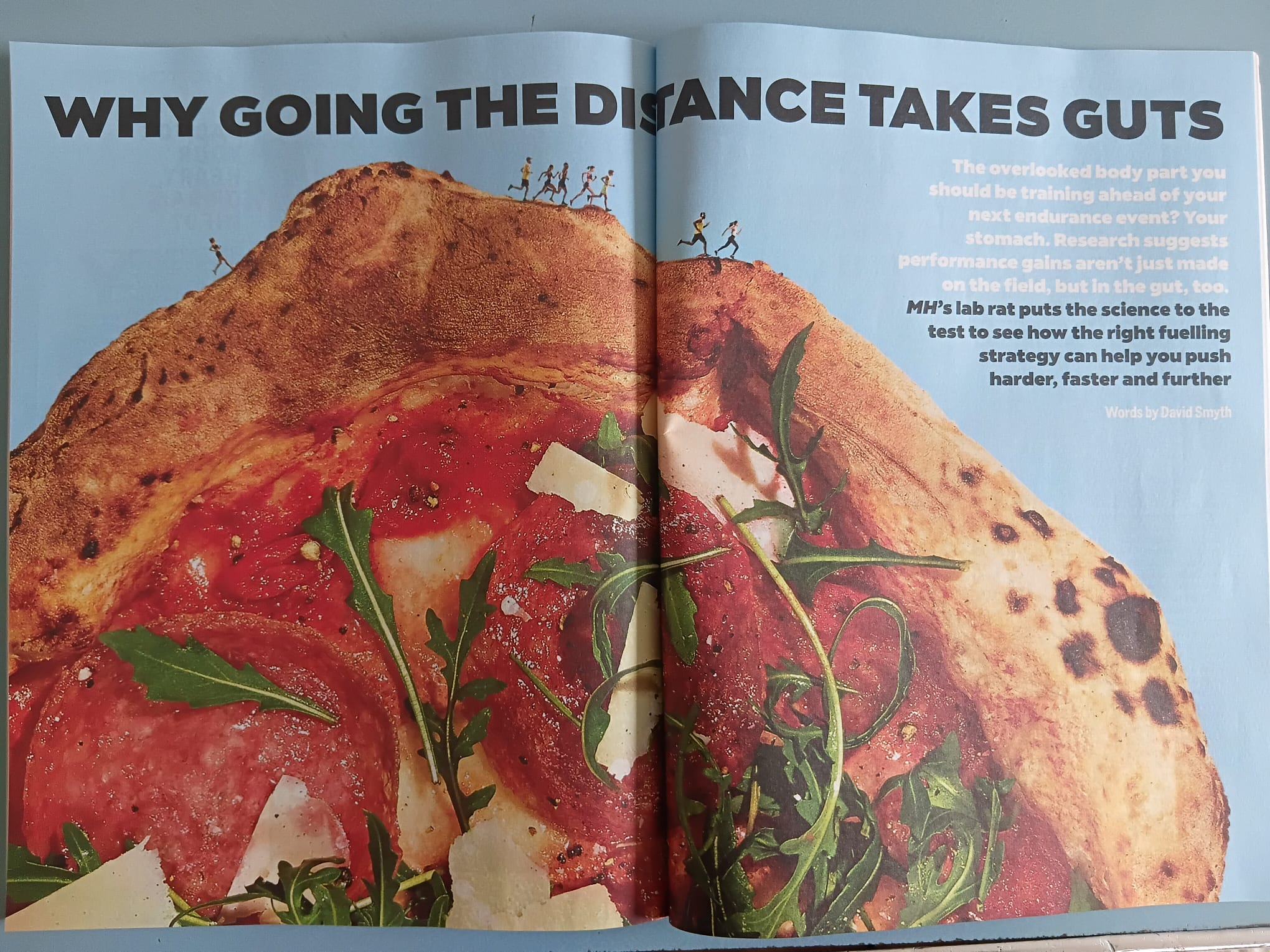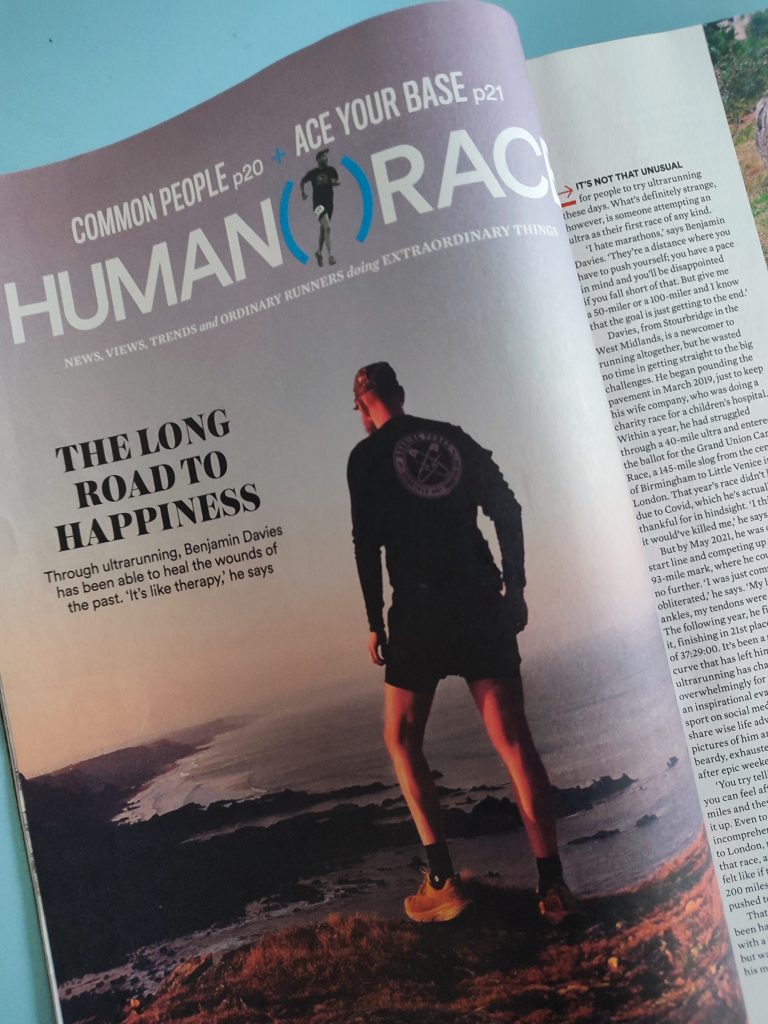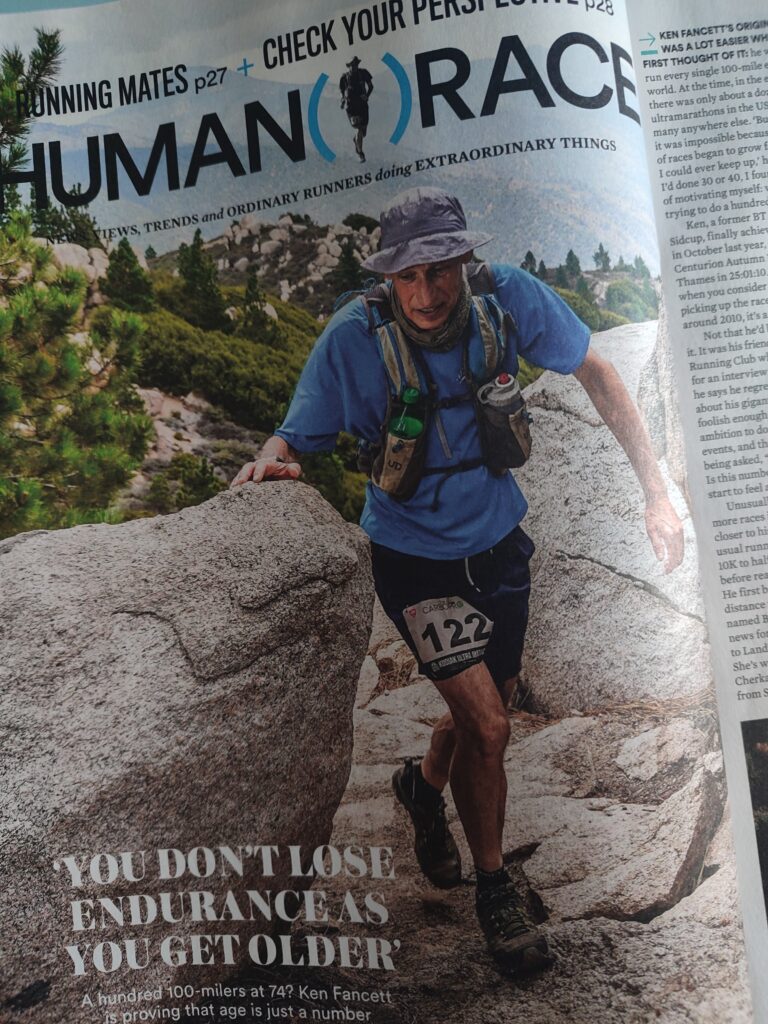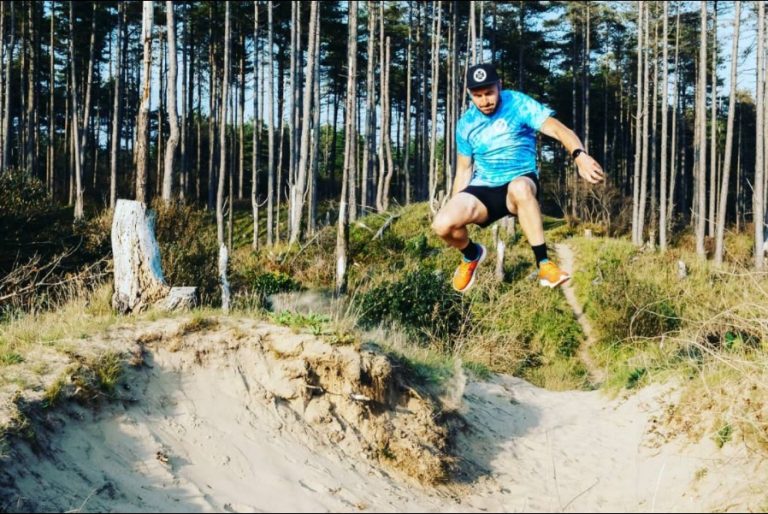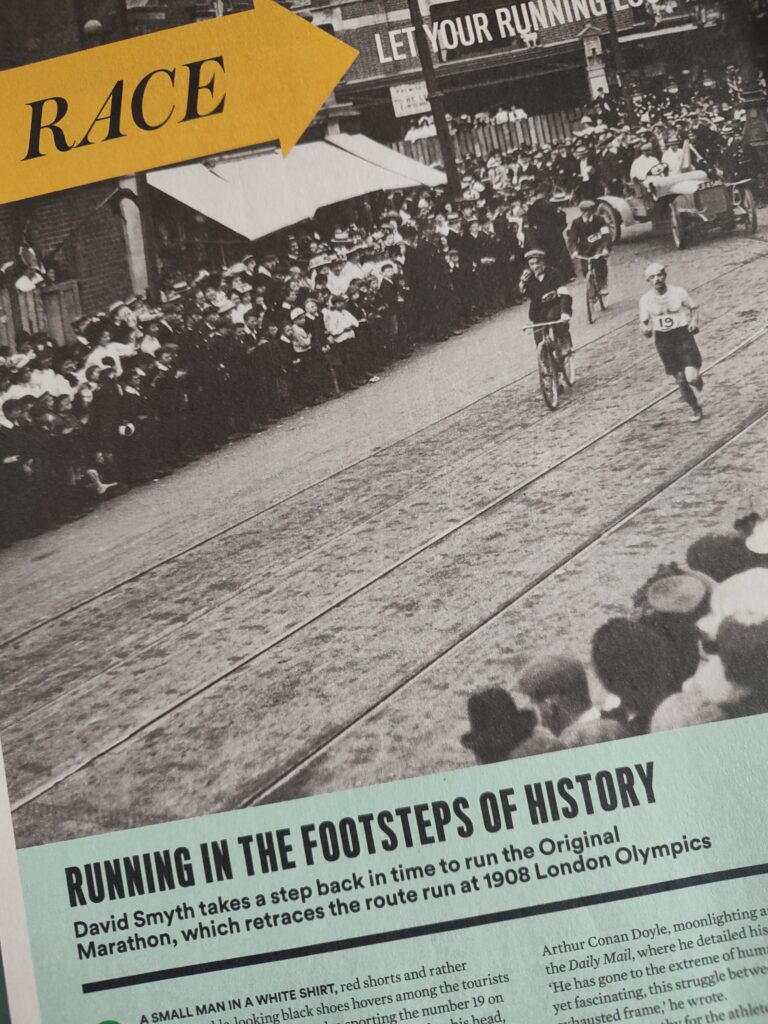WHY GOING THE DISTANCE TAKES GUTS – Men’s Health, Oct 2025 issue
I’m sitting at my computer, studying a detailed report all about me. It was put together by the School of Sport Sciences at Liverpool John Moores University in collaboration with the leading nutrition company Science in Sport, and contains a number of cool photos of me running on a treadmill wearing a gas mask with two long corrugated tubes attached, looking as though I have either been accepted onto the Space Programme or cast as a Batman villain. However, the chart I’m looking at features six bars labelled ‘Urge to defecate’, ‘Gas/flatulence’, ‘Abdominal cramps’, ‘Stomach fullness’, ‘Regurgitation’ and ‘Nausea.’ The last time I was required to rank farts was on a school camping trip. This time, it’s serious.
The sporting community euphemistically calls it ‘GI distress’. Translation: ‘When you gotta go, you gotta go.’ I was invited to Liverpool to learn about how we should be fuelling ourselves for endurance sports such as running, cycling and triathlon. The current thinking is that bigger is better, but there’s an unfortunate flipside to that which also needs to be considered. As I discovered earlier this year when attempting to fuel a 16-hour running challenge with a combination of flat Coke, mini pork pies and Haribo, it isn’t just bears who shit in the woods.
The sports scientists tend to talk in terms of grams of carbohydrate per hour, rather than calories. You can find grams of carbs labelled on the back of every food packet. ‘What’s changing now is what the term “high intake” means,’ says Dr Jamie Pugh, a senior lecturer at LJMU who also represents Wales in 100km running events. ‘Something like 15 years ago, 60 grams an hour might have been considered a high intake. Only five years ago, 90 grams was the new big number. Now we’re seeing 120, and if you look at cycling, it’s even getting up to 160 or 200.’
Let’s visualise 120g of carbs in a way we can all understand: that’s about five medium bananas, or nine slices of white bread, or three and a half cans of Coke, or seven tablespoons of honey. Every hour. Yet among the pro endurance athletes who publicise their nutrition data, it’s an increasingly common figure. One of the first to go really big was the cyclist Chris Froome, whose surprise 2018 victory on the 19th stage of the Giro d’Italia, a 184km day including the 18.6km, 9.1% gradient climb up the Colle delle Finestre, is still talked about in awestruck terms by fans. He consumed 14 gels and two bottles of Science in Sport Beta Fuel during the full ride – reaching 96g of carbs an hour.
The American ultrarunner Jim Walmsley was also an unusual fueller when he was first making a name for himself. When interviewed about his success in 2017, he gave most of the credit to pizza and said that during races, ‘I typically stick to sugar hydration drinks and gels, averaging about 400 to 450 calories per hour.’ That’s about 100-112g of carbs. Even down at marathon distances, Eliud Kipchoge was reported to be taking on 100g an hour, using a high carb drink mix created by the Swedish brand Maurten, during his 2017 and 2019 attempts to break the two hour barrier.
Today this kind of thing is pretty standard at the top level. At June’s Western States Endurance Run, a scorching hot 100-mile trail race across the Sierra Nevada Mountains of California, the winner Caleb Olson took on 109g of carbs an hour over 14 hours to set the second fastest time ever, two minutes behind Walmsley’s 2019 record. Second place Chris Myers managed to consume 126g per hour.
It’s understandable that Olson’s and Myers’ nutrition sponsors, Precision Fuel & Hydration, would be trumpeting the news that the more of their products you use, the faster you go, but it looks that way across the board. Until he dropped out of Western States at the 62 mile mark (not for nutrition-related reasons) the athlete talking the loudest about high carb fuelling was David Roche. The Colorado-based runner was better known as a coach and podcaster until very recently, when he began entering 100-mile races and doing remarkably well, giving a large amount of the credit for his sudden ascent to the quantity of carbs he was gorging. He studied people who enter competitive eating contests such as Joey Chestnut, who can get more than 70 hot dogs down in 10 minutes, and worked on his gut training as much as his speed. ‘While my training and talent might not be record breaking, I am a superstar at slurping,’ Roche has said.
So why is all the talk about carbs when our bodies also burn fat for fuel, and how did the experts arrive at these numbers? Since scientists developed muscle biopsy techniques in the late 1960s, it has been understood that our capacity for high performance in exercise is determined by how much glycogen – which is the form in which our bodies store carbohydrates – is available in the muscles (and also the liver). We naturally store somewhere between 400-600g of carbs in our bodies at rest, getting towards the higher end if we do enough ‘carb loading’ in the meals we eat before a race. This is our ‘endogenous’ store, but it will only get us so far – maybe around two hours, depending on pace and intensity – hence the notion of ‘hitting the wall’ during a marathon. We do also burn fat, but if you want to go fast, it’s carbs you need.
‘I always say it’s like gears in a car,’ explains James Morton, Professor of Exercise Metabolism at LJMU and Chief Scientific Officer at Science in Sport. He has also worked as the Head of Nutrition for both Liverpool FC and Team Sky in cycling. ‘Gears one, two, three, you’re using fat, but four, five, six, it’s carbohydrates.’
Even in shorter, more intense competitions, additional fuelling (your ‘exogenous’ carbs) is becoming more necessary. Adam Corlett, who recently won the men’s 40-44 category at the HYROX World Championships in Chicago, says that he has a 40g SIS Beta Fuel gel five to 10 minutes before a race, then another about 20 minutes into it, usually after the sled pull, which is the third of the eight exercises. ‘A HYROX race might take an hour to 75 minutes on average, so people were under the impression the body is already storing enough carbohydrate to finish the session,’ he tells me. ‘But because the intensity of the workout is much higher than a marathon or an Ironman, you rinse through those stores a lot quicker. A lot more people are now refuelling around 20 minutes in, so with 40 or so minutes to go that’s enough time for it to get into the bloodstream and work its magic.’
Scientists understood that the body can digest and absorb glucose at a rate of about 1g per minute, which is where the 60g carbs an hour advice came from. Then in the early part of the 2000s they discovered that a structurally distinct sugar, fructose, is absorbed by a different intestinal transporter, so it can be used in addition. Newer fuels such as Precision’s use a 2:1 glucose to fructose ratio, allowing 90g an hour of carbs. However SIS Beta Fuel now pushes the figure even higher, with a ratio of 0.8g fructose to every 1g glucose. The thinking is that the body’s limit hasn’t yet been reached.
So far, there hasn’t been much in the way of major scientific studies that can corroborate the ideal numbers. A study in the journal Physiological Reports in 2018 concluded that 90g per hour was ‘optimal’ for cyclists in time trials. The same study also tested 112.5g/hour and suggested that there wasn’t any additional exogenous carb use from the body at that level. However, a test of elite mountain marathon runners in 2020 found that taking on 120g/hour could ‘limit neuromuscular fatigue and improve recovery’ compared to lower intakes, but it only tested 26 men, six of whom didn’t complete the study because of injury or GI issues. Another in 2022 tried nine cyclists on 120g/hour and found that the dose was beneficial whether taken in the form of drink, gel, chew or a combination, with a ‘relative lack of gastrointestinal symptoms’.
What’s most convincing in the latter report is a series of graphs showing the quantity of both carbs and fat being burned as exercise goes on. At the beginning, the body is using mostly carbs, but as time progresses that line goes down while the line for fat goes up. When taking on only water, fat takes over from carbs as the dominant fuel source at around the two hour mark for cyclists. ‘That’s the point where you start to feel that exercise is a lot harder,’ says James Morton from LJMU. But with 120g additional carbs per hour, that crossover point still hadn’t arrived after three hours. Morton shows me a soon to be published study of his own, funded by Science in Sport and partnered with England Athletics, which again shows that the crossover to fat dominance doesn’t happen when taking on 120g/hour, this time in elite male marathon runners going at race pace for two hours. ‘It also improves running economy when compared with both 90g and 60g,’ he says. ‘This is a major finding and really challenges the current guidelines that 90g is the upper limit of carbohydrate ingestion that runners should follow. World tour cyclists routinely ingest 120g and above and we think that runners will soon follow suit.’
How about the gut though? This kind of extreme fuelling is a bit easier for cyclists to cope with because they’re generally having a smoother ride than runners. ‘We do tend to see that cyclists can tolerate carbohydrate much better than runners,’ says Morton. ‘For a marathon runner going at high intensity the whole time, the blood flow to the gut is completely different.’
Plus there’s the extra agitation caused by the up and down movements and impact on the ground for runners. During the worst spells of my recent ultra challenge, I could walk easily, but as soon as I started jogging, my insides felt very fragile. Dr Sam Shepherd, Head of Sports Science at Precision Fuel & Hydration, is also a top triathlete with a number of Ironman races under his belt. He says that during triathlons he wouldn’t fuel at all during the swim and would concentrate most of his intake on the bike. ‘At Precision we’ve got about 300 case studies of middle and long distance triathletes. I would say for most of those, the athlete is having a higher amount of carb on the bike, then dropping it off for the run,’ he says. ‘You fuel heavy on the bike to set up the run because tolerating that amount is more difficult when you’re running.’
The top runners say you can learn to take it, though. When I chat to CJ Albertson, he’s eating a bowl of white rice and fish for breakfast – unusual for an American, but the 31-year-old is the current world record holder for the 50km run and has been selected for the USA marathon team at the 2025 World Athletics Championships in Tokyo. He says that when he started marathon running in 2018 he was making his own carb drinks, ‘But it was really hard to drink all those calories. I couldn’t get that much volume down.’ Now, using Precision’s gels, he’s up to about 110g an hour of carbs. ‘Having that carb intake go up allows me to race at a higher intensity for the whole race and not be limited by fuel,’ he says.
How did he get the number higher? Just through practice, as with all forms of race training. ‘I’ve had about six years of upping the dose and that minimises the GI distress. I think fuelling in training is really where people can can get the most gains and then, when they do it in a race, it’s just second nature.’
Josh Wade says something similar. He’s a Lake District-based runner with top 10 finishes in a wide range of major ultra races. ‘I went to [ultrarunning’s biggest event] UTMB two years ago and had some stomach problems because I was loading too many carbs at once,’ he tells me. ‘Now I drip feed myself. Every 20 minutes something’s going in. I’m not getting dips in energy. I’m consistent from the start to the end.’
He’s even fuelling big with SIS products in training: ‘Five years or so ago, I would wake up the next day and not be ready to go again. I needed more recovery. Now I can bounce back much more easily.’
These are full-time athletes though. What does this mean for the rest of us? Just because a bigger boy does something doesn’t mean you should too. Dr Shepherd points out that if you’re working more slowly, really high fuelling is less of an issue, but if you’re out for a long time, you do still need to take something extra on board. ‘It’s about intensity and also duration. Those are the two things we would consider,’ he says. ‘Anything over three hours, you should be fuelling at 60g per hour plus.’
In order to find out how this could work for a non-elite athlete, I’ve taken myself to a lab at Liverpool John Moores University lined with treadmills and stationary bikes, where James Morton, Jamie Pugh and their Phd student Samanvita Ravikanti recently hosted Tokyo Olympic 10,000m champion Selemon Barega. They’re polite enough not to show how underwhelming it is to spend an afternoon doing fingerprick blood tests and adjusting sweaty heart rate monitors on a 47-year-old journalist whose most recent marathon time is around 3:16.
First they work out my lactate threshold – the top pace I can maintain while my body is still able to clear away lactate from my blood – by making me run for three minutes at 10km/h, 11 km/h and so on up to 16km/h. Then they find my VO2max – the highest amount of oxygen I can use during exercise – by making the treadmill go gradually faster and its incline go upwards until I’m physically unable to carry on. Meanwhile they’re collecting my breath to analyse the proportions of carbs and fat my body is burning.
With these numbers they can set me a marathon race pace of 13.5km/h and get me to run at that speed for a full hour while drinking 600ml of SIS Beta Fuel – three 200ml doses containing 40g of carbs, totalling the magic 120g for the hour. Then, while I’m motoring away, they start asking about flatulence.
Remarkably, especially so soon after the VO2max test, I feel as if I could comfortably carry on much further at that pace, and although there are a few burps, I don’t need to jump off the treadmill and use my top race pace to sprint to the toilet. I haven’t had any practice with this kind of fuelling, so if I was to build up to that quantity gradually over weeks of training, they think I’d be fine.
Their report concludes that when I next run a marathon, I’ll spend approximately 4.5 grams per minute of carbs and a total of 837g: ‘This is considerably more than your body can store and clearly illustrates the requirement to fuel during the race.’ The sports scientists also propose that I should have ‘a carbohydrate loading protocol of at least 8-12g/kg body mass for two days before the race, a pre-race meal of 2-3g/kg and in-race fuelling plan of 90-120g per hour.’
That’s a lot, but looking at what’s going on at elite level now, it does seem to be a new frontier in endurance performance. ‘Everybody says to me, “I hope you have a good dentist!”’ says Josh Wade. ‘Once I’m out of racing season I’ll switch back to less sugar. But I’m excited to see where this will go. It could go even further.’ And so will he.
= = = = = = = = = = = = = = = = = = =
GUT TRAINING TIPS
If you’re going to try to take on a really high quantity of carbs during a race, you’re going to need to practise, just as with every other aspect of your training. ‘There’s no special formula other than a bit of trial and error. The key thing is reflecting on it afterwards,’ says Sam Shepherd from Precision F&H.
The Dutch sports nutrition scientist Asker Jeukendrup is an authority in this area. He recommends incorporating gut training into your routine for 5-10 weeks at least once a week before a race. In 2017 he published an overview of the evidence in the journal Sports Medicine, titled ‘Training the Gut for Athletes’ from which we can take the following tips:
Gradually increase the amount of carbs in your diet overall
This will improve your body’s ability to oxidise the carbohydrate you take on. It should also improve your stomach comfort and lessen the feeling of ‘fullness’.
Practise race day nutrition in training sessions
Training is when you can try out different products to learn what your body tolerates best. Don’t do anything for the first time on race day.
Train consistently with high carb intake
Doing this in practice helps your body to get better at gastric emptying (how fast any food leaves your stomach) and at absorbing nutrients in the intestines.
Train with gradually increasing volumes of fluid
This should help with reducing any feelings of bloatedness and fullness.
Train straight after a meal
Again, you’re teaching your body to get faster at gastric emptying, and making it more efficient at absorbing carbs.
